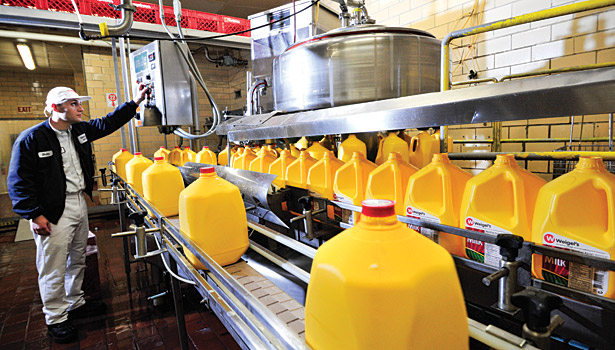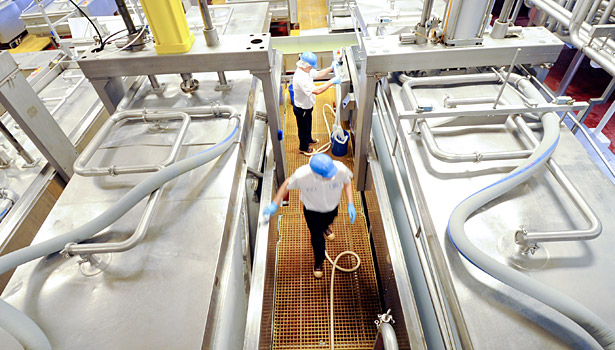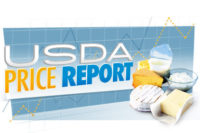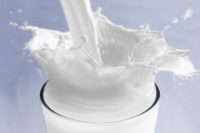Milk production continues to be impacted by weather conditions across wide areas of the United States; cheese plants are worried about milk supplies; and nonfat dry milk prices are moving higher across all regions in a firm market, reports the U.S. Department of Agriculture.
Here are highlights from the U.S. Department of Agriculture's Dairy Market News for the week of July 30 to Aug. 3:
 FLUID MILK. Milk production continues to be impacted by weather conditions across wide areas of the U.S. Class I demand is beginning to increase as schools start in some areas of the country and demand will build over the next month. Cream markets are mostly steady to firm with fair to good demand noted from butter and ice cream accounts. The Northeast and Midwest are seeing milk output leveling off and areas are receiving some much-needed rainfall for crop and pasture growth. In the Southeast and Florida, milk output is at seasonal low levels and manufacturing is also at low levels. In the Southwest, milk output is trending lower. Monsoon conditions in Arizona are lowering milk receipts. In the Northwest, milk output is steady and along expected levels as conditions are favorable.
FLUID MILK. Milk production continues to be impacted by weather conditions across wide areas of the U.S. Class I demand is beginning to increase as schools start in some areas of the country and demand will build over the next month. Cream markets are mostly steady to firm with fair to good demand noted from butter and ice cream accounts. The Northeast and Midwest are seeing milk output leveling off and areas are receiving some much-needed rainfall for crop and pasture growth. In the Southeast and Florida, milk output is at seasonal low levels and manufacturing is also at low levels. In the Southwest, milk output is trending lower. Monsoon conditions in Arizona are lowering milk receipts. In the Northwest, milk output is steady and along expected levels as conditions are favorable.
 CHEESE. Cheese prices have traded up and down in a narrow range for the last three weeks. Contracted loads into large commercial customers have been moving well with some additional interest being shown for increased loads. Supplies are adequate for these needs, but inquiries from brokers looking to purchase spot loads are sometimes being deferred in favor of additional sales to continuing customers. Cheese plants are worried about milk supplies, especially in areas that have experienced hot, humid weather. Cheese plants would like to increase production schedules for fall foodservice needs, but are not getting all the milk they desire. Specialty cheese makers are having some difficulties in dry areas, getting pasture grazed milk to fill orders
CHEESE. Cheese prices have traded up and down in a narrow range for the last three weeks. Contracted loads into large commercial customers have been moving well with some additional interest being shown for increased loads. Supplies are adequate for these needs, but inquiries from brokers looking to purchase spot loads are sometimes being deferred in favor of additional sales to continuing customers. Cheese plants are worried about milk supplies, especially in areas that have experienced hot, humid weather. Cheese plants would like to increase production schedules for fall foodservice needs, but are not getting all the milk they desire. Specialty cheese makers are having some difficulties in dry areas, getting pasture grazed milk to fill orders
DRY PRODUCTS. Nonfat dry milk prices are moving higher across all regions in a firm market. Buying interest has been fair to good as the market prices moved higher in recent weeks. Index pricing is tempering some of the price movement and there is some price resistance at the top of the current market ranges. Dry whey prices are steady to firm in all regions. Demand is moderate to good with some buyers looking for spot loads and others seeking to increase their contract volumes. Whey protein concentrate 34% prices are steady after several weeks of decline.
INTERNATIONAL DAIRY MARKET NEWS. The calendar indicates that winter is still in the Oceania region, but pastures are starting to green and more signs of spring are developing. No noticeable increases in milk production are being reported, but by the end of the month, this trend will change. Milk producers and handlers are very optimistic about the upcoming production season. A strong finish to the previous season, generally favorable winter weather conditions, and good cow conditioning are some of the factors that typically signal a positive start to a new production season.
The milk production season throughout Europe continues to trend lower at varying rates. Weather conditions are the main factors that are influencing the rate of decline. Hot temperatures in southern regions and cooler/wet conditions in northern regions are the main factors in production declines. Milk output declines in Ireland are greatly influencing milk volumes and logistics.


